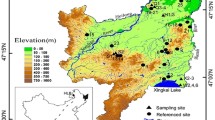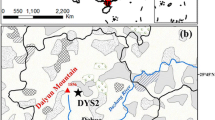Abstract
High-resolution peat humification records were obtained from Dajiuhu of the Shennongjia Mountains and Qianmutian of the Tianmu Mountains to study climate changes in East China. The analyses of pollen, organic matters, TOC, and Rb/Sr indicate a high degree of peat humification and thus strong decomposition of organic matter when climate was dry. Conversely, when climate was humid, the degree of humification is low because peat was preserved in a waterlogged condition. Peat humification from Dajiuhu occurred not only during the Younger Dryas (about 11.4–12.6 cal ka BP), the Bølling-Allerød Warm Period (12.6–15.2 cal ka BP), and the Oldest Dryas (about 15.2–16.0 cal ka BP), but also during the early Holocene (about 11.4–9.4 cal ka BP), the 8.2 cal ka BP cold event, and the Holocene Optimum (about 7.0–4.2 cal ka BP). Both peat humification records since nearly 5 ka BP are consistent, showing that mountain peatland has synchronous responses to the East Asia monsoon-induced precipitation. The LOI data confirm the above observation. The monsoon precipitation since nearly 5 ka BP recorded in these two peat profiles can be divided into three phases. During 4.9–3.5 ka BP, precipitation amount was high but fluctuated greatly. During 3.5–0.9 ka BP, precipitation amount was low. During 0.9–0 ka BP, degree of humification reduced gradually, indicating the increase of monsoon precipitation. Contrast to other high-resolution records from East China monsoon region shows that the monsoon precipitation records of the two peat profiles since nearly 16 ka BP are controlled by a common forcing mechanism of summer solar radicalization in the Northern Hemisphere.
Similar content being viewed by others
References
Qin J M, Yuan D X, Cheng H, et al. The Y. D. and climate abrupt events in the early and middle Holocene: Stalagmite oxygen isotope record from Maolan, Guizhou, China. Sci China Ser D-Earth Sci, 2005, 48(4): 530–537
Shen J, Yang L Y, Yang X D, et al. Lake sediment records on climate change and human activities since the Holocene in Erhai catchment, Yunnan Province, China. Sci China Ser D-Earth Sci, 2005, 48(3): 353–363
Hong Y T, Wang Z G, Jiang H B, et al. A 6000-year record of changes in drought and precipitation in northeastern China based on a δ 13C time series from peat cellulose. Earth Plant Sci Lett, 2001, 185: 111–119
Feng Z D, An C B, Wang H B. Holocene climatic and environmental changes in the arid and semi-arid areas of China: A review. Holocene, 2006, 16(1): 119–130
Zhu C, Zheng C G, Ma C M, et al. On the Holocene sea-level high-stand along the Yangtze Delta and Ningshao Plain, East China. Chin Sci Bull, 2003, 48(24): 2672–2683
Wu W X, Liu T S. Possible role of the “Holocene Event 3” on the collapse of Neolithic Cultures around the Central Plain of China. Quat Int, 2004, 117: 153–166
Chambers F M, Charman D J. Holocene environmental change: Contributions from the peatland archive. Holocene, 2004, 14(1): 1–6
Blackford J. Palaeoclimatic Records from peat bogs. Trends Ecol Evol, 2000, 15(5): 193–198
Zhou W J, Yu X F, Jull A J T, et al. High-resolution evidence from southern China of an early Holocene optimum and a mid-Holocene dry event during the past 18000 years. Quat Res, 2004, 62(1): 39–48
Tao F X, Hong Y T, Jiang H B. Climatic change over the past 8000 years in Caohai District, Guizhou. Chin Sci Bull, 1997, 42(5): 1489–1492
Xu H, Hong Y T, Lin Q H, et al. Temperature responses to quasi-100-yr solar variability during the past 6000 years based on δ 18O of peat cellulose in Hongyuan, eastern Qinghai-Tibet plateau, China. Palaeogeogr Palaeoclimatol Palaeoecol, 2006, 230(1–2): 155–164
Zhong W, Wang L H, Xipulati T, et al. Possible solar forcing of climate variability in the past 4000 years inferred from a proxy record at the southern margin of Tarim Basin. Chin Sci Bull, 2004, 49(11): 1190–1195
He B Y, Zhang S, Cai S M. Climatic changes recorded in peat from the Dajiu Lake Basin in Shennongjia since the last 2600 years (in Chinese). Mar Geol Quat Geol, 2003, 23(2): 109–115
Chai X. Peat Geoscience (in Chinese). Beijing: Geological Publishing House, 1990. 1–4
Blackford J J, Chambers F M. Determining the degree of peat decomposition for peat-based paleaoclimatic studies. Int Peat J, 1993, 5: 7–24
Blackford J J. Proxy climate record for the last 1 000 years from Irish blanket peat and possible link to solar variability. Earth Plant Sci Lett, 1995, 133: 145–150
Caseldine C, Gearey B. A multiproxy approach to reconstructing surface wetness changes and prehistoric bog bursts in a raised mire system at Derryville Bog, Co. Tipperary, Ireland. Holocene, 2005, 15(4): 585–601
Blackford J J, Chambers F M. Proxy records of climate from blanket mires: Evidence for a Dark Age (1400 BP) climatic deterioration in the British Isles. Holocene, 1991, 1(1): 63–67
Chambers F M, Barber K E, Maddy D, et al. A 5500-year proxy-climate and vegetation record from blanket mire at Talla Moss. Borders, Scotland. Holocene, 1997, 7(4): 391–399
Anderson D E. A reconstruction of Holocene climatic changes from peat bogs in northwest Scotland. Boreas, 1998, 27: 208–224
Mauquoy D, Barber K E. A replicated 3000 yr proxy-climate record from Coom Rigg Moss and Felecia Moss, the Border Mires, northern England. J Quat Sci, 1999, 14: 263–275
Wang H, Hong Y T, Zhu Y X, et al. The pear humification records of Holocene climate change in Hongyuan region (in Chinese). Geol Geochem, 2003, 31(2): 51–56
Wang H, Hong Y T, Zhu Y G, et al. Humification degrees of peat in Qinghai-Xizang Plateau and palaeoclimate change. Chin Sci Bull, 2004, 49(5): 514–519
Yu X F, Zhou W J, Shi J F. A convenient method for peat humification derermination: Grayscale (in Chinese). Mari Geol Quat Geol, 2005, 25(1): 133–136
Yu X F, Zhou W J, Lars G F, et al. High-resolution peat records for Holocene monsoon history in the eastern Tibetan Plateau. Sci China Ser D-Earth Sci, 2006, 49(6): 615–621
Zhou W J, Liu X F, Wu Z K, et al. Peat record refleering Holocene climatic change in the Zoigê Platean and AMS radiocarbon dating. Chin Sci Bull, 2002. 47(1): 66–70
Stuiver M, Reimer P J, Bard E, et al. INTCAL98 Radiocarbon age calibration 24000–0 cal BP. Radiocarbon, 1998, 40: 1041–1083
Deam W E. Determination of carbonate and organic matter in calcareous sediments and sedimentary rocks by loss on ignition: Comparison with other methods. Inte Peat J, 1974, 44: 242–248
Zhang J H, Kong Z C, Du N Q. The despondence of Loss-on-ignition range to past climate and environment in Beijing. Acta Ecol Sin, 1998, 18(4): 343–347
Zhu C, Ma C M, Zhang W Q, et al. Pollen record and environmental changes from Dajiuhu Basin of Shennongjia since 15.753 ka BP (in Chinese). Quat Sci, 2006, 26(5): 814–826
Zheng C G. Environmental archaeology research to space-time distribution of cultural sites in Taihu Lake region during 7–4 ka BP. Dissertation for Doctor Degree. Nanjing: Nanjing University, 2005. 55–66
Bai G R, Wang S Z, Gao J, et al. Liquid-heat conditions and microbic decomposition on the forming of Turf Deposits (in Chinese). J Shanghai Normal University (Natural Sciences), 2004, 33(3): 91–97
Caseldine C J, Baker A, Charman D J, et al. A comparative study of optical properties of NaOH peat extracts: Implications for humification studies. Holocene, 2000, 10(5): 649–658
Robert K B, Stephen T J. A high-resolution record of late-Holocene moisture variability from a Michigan raised bog, USA. Holocene, 2003, 13(6): 863–876
Borgmark A. Holocene climate variability and periodicities in south-central Sweden, as interpreted from peat humification analysis. Holocene, 2005, 15(3): 387–395
Zhao Y, Hölzer A, Yu Z C. Late Holocene natural and human-induced environmental change reconstructed from peat records in Eastern central China. Radiocarbon, 2007, 49: 789–798
Chen J, An Z S, Wang Y J, et al. Distribution of Rb and Sr in the Luochuan loess-paleosol sequence of China during the last 800 ka: Implications for paleomonsoon variations. Sci China Ser D-Earth Sci, 1998, 28(6): 498–504
Jin Z D, Zhang E L. Paleoclimate implication of Rb/Sr ratios from lake sediments (in Chinese). Sci Tech Eng, 2002, 2(3): 20–22
Dykoski C A, Edwards R L, Cheng H, et al. A high-resolution, absolute-dated Holocene and deglacial Asian monsoon record from Dongge Cave, China. Earth Plant Sci Lett, 2005, 233: 71–86
Wang Y J, Cheng H, Edwards R L, et al. Millennial- and orbital-scale changes in the East Asian monsoon over the past 224000 years. Nature, 2008, 451: 1090–1093
Hong Y T, Hong B, Lin Q H, et al. Inverse phase oscillations between the East Asian and Indian Ocean summer monsoons during the last 12000 years and paleo-El Nino. Earth Plant Sci Lett, 2005, 231: 337–346
Zhou W J, Xie S C, Meyers P A, et al. Reconstruction of late glacial and Holocene climate evolution in southern China from geolipids and pollen in the Dingnan peat sequence. Org Geochem, 2005, 36: 1272–1284
Xiao J Y, Lu H B, Zhou W J, et al. Evolution of vegetation and climate since the last glacial maximum recorded at Dahu peat site, South China. Sci China Ser D-Earth Sci, 2007, 50(8): 1209–1217
Liu X Q, Shen J, Wang S M, et al. A 16000-year pollen record of Qinghai Lake and its paleoclimate and paleoenvironment. Chin Sci Bull, 2002, 47(22): 1931–1936
Shen J, Liu X Q, Ro M, et al. A high-resolution climatic change since the Late Glacial Age inferred from multi-proxy of sediments in Qinghai Lake. Sci China Ser D-Earth Sci, 2005, 48(6): 742–751
Wang S Y, Lu H Y, Liu J Q, et al. The early Holocene optimum inferred from a high-resolution pollen record of Huguangyan Maar Lake in southern China. Chin Sci Bull, 2007, 52(20): 2829–2836
Yancheva G, Nowaczyk N R, Mingram J, et al. Influence of the intertropical convergence zone on the East Asian monsoon. Nature, 2007, 445: 74–77
Zheng Z, Wang J H, Wang B, et al. High-resolution records of Holocene from the Shuangchi Maar Lake in Hainan Island. Chin Sci Bull, 2003, 48(5): 497–502
Shao X H, Wang Y J, Cheng H, et al. Stalagmite record of monsoon climate changes and arid events from Shennongjia of Hubei Province. Chin Sci Bull, 2006, 51(1): 80–86
Chen F H, Huang X Z. Yang M L, et al. Westerly dominated Holocene climate model in arid central Asia—Case study on Bosteng Lake, Xinjiang (in Chinese). Quat Sci, 2006, 26(6): 881–887
Author information
Authors and Affiliations
Corresponding author
Additional information
Supported by National Key Technology R&D Program (Grant No. 2006BAK21B02), the National Natural Science Foundation of China (Grant No. 40701190), the Key Project of the National Natural Science Foundation of China (Grant No. 90411015), the University Doctoral Foundation of China (Grant No. 20070284067) and the Test Foundation of Modern Analyses Center of Nanjing University
Rights and permissions
About this article
Cite this article
Ma, C., Zhu, C., Zheng, C. et al. Climate changes in East China since the Late-glacial inferred from high-resolution mountain peat humification records. Sci. China Ser. D-Earth Sci. 52, 118–131 (2009). https://doi.org/10.1007/s11430-009-0003-5
Received:
Accepted:
Published:
Issue Date:
DOI: https://doi.org/10.1007/s11430-009-0003-5




